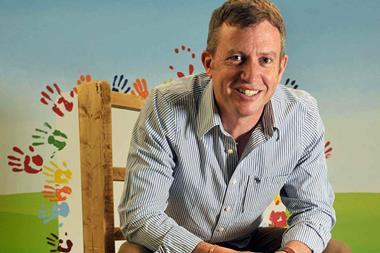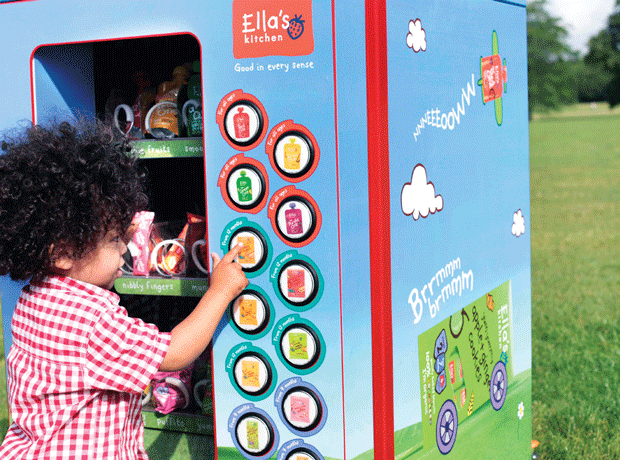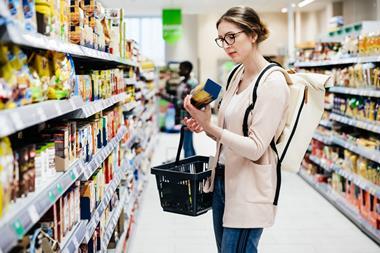Organic babyfood maker Ella’s Kitchen has been sold to US food giant Hain Celestial for an undisclosed sum.
Ella’s Kitchen founder, Paul Lindley, started the company in 2006, naming it after his daughter. He will now head up the newly formed Global Infant, Toddler & Kids Division. He tells The Grocer exclusively his thoughts on the deal.
Paul Lindley: Hain Celestial has bought 100% of the equity in Ella’s Kitchen, for an undisclosed sum. There is no earnout. They’ve bought it outright.
It’s a fantastic opportunity. We’ve now got the opportunity to reach not one billion tiny tummy touchpoints, but four billion! I’m really excited by that, having a bigger footprint around the world, and the fact that I can focus on innovation, marketing, distribution.
“Combining our sales of £50m-60m with their sales of $200m, they’re entrusting a British entrepreneurial team to manage that, so it’s exciting”
We want to put as much as possible into that, whereas if we had continued alone, we would have had to spend a lot more on the back office stuff.
We’re creating a global infant toddler division within Hain Celestial, operating as a standalone company and reporting into the CEO, for the Earth’s Best and Ella’s Kitchen brands. The team of people at HC’s Lake Success HQ will report into me. It has sales of $200m (£128m).
Our team of five-six people in the US office will merge. We will continue to be based in our barn in Oxfordshire. But combining our sales of £50m-60m with their sales of $200m, they’re entrusting a British entrepreneurial team to manage that, so it’s exciting.
There are no announcements on the team, but the team here will be responsible for aspects of the broader group.
The Grocer: Is it true you’ve struggled to sell it?
PL: We’ve not struggled to sell it. But I’ve personally been very careful in selecting a partner. This one I truly think has a very good reputation. The mindset overlaps with my own.
I’ve known Irwin for four-five years. We tied it down over the last few months.

I’ve always talked about our desire to reach a billion tiny tummy touchpoints. And the decision on who to work with was always about how we get there. One way is by partnering using expertise, or distribution, or just financial stuff. For 18 months, there’ve been a lot of people knocking on our door thinking they can help us get there quicker, or with less risk. And we’ve listened to some. But in choosing a partner there were, as I saw it, three hurdles:
“There’s great innovation that we can share under each other’s brands”
Would our partner see the world the same way we do? I’m a great believer in children’s health, good nutrition, using profits to make a better world for young kids. Irwin Simon [CEO of Hain Celestial] has done something very similar: he’s grown the Global Earth babyfood brand from $14m to $200m while keeping the integrity and the value, improving wellness and health.
A lot of this comes down to personal chemistry, and Irwin’s passion for the consumer really resonated with me. So Hain Celestial cleared that hurdle.
Second was the value equation. We placed a high value on what we’ve achieved in the UK and around the world. Obviously there’s a discussion. We’ve landed on a value. But that’s not been disclosed.
Read this
Paul Lindley on family-friendly business
“Running a business creates challenges for parents”
And the third was: how will it work? What are they bringing? And the answer is this partnership brings a whole load of things.
[There are] opportunities for efficiencies in our supply chain. And territory wise, we complement each other. They’re strong in the US; we have a strong European base: we’re the no. 1 babyfood brand in the UK, and have strong and growing share in Scandinavia, as well as growth in pretty much every market we’re in.
It’s a question of building synergies. And in the US we also complement each other well: we have different consumer bases and channels. Our biggest customer is Target and we’re quite strong in grocery [via retail chain Kroger]. Hain is very strong in the natural channel: Toys R Us and Babies R Us and Whole Foods. We did come out of Babies R Us a couple of years ago, so that’s useful to be able to leverage.
Also there’s the product development piece. There’s great innovation that we can share under each other’s brands. There’s no plan to bring the Earth’s Best brand to the UK but there’s lots of products that we can share. And there’s the talent we’ve both got entrepreneurially. We share that. Hain Daniels has supply chain capacity that we might also tap into in the future.
The Grocer: How does Ella’s market share currently stand internationally?
PL: We have 30% market share in Norway. Ten percent in Sweden. They’re our two most established markets.
Our fastest growing is the US, where we grew sales 55% last year. We’ve been there since 2009. But it’s a fast-moving and competitive market. This deal makes sense for us there to reduce our risk around investment. Without Hain, it would be going to the back end, rather than the consumer.
Other markets include Australia, South Africa, Canada. We expect to launch into other markets later in the year. We’ve got similar growth all over the place.


















No comments yet